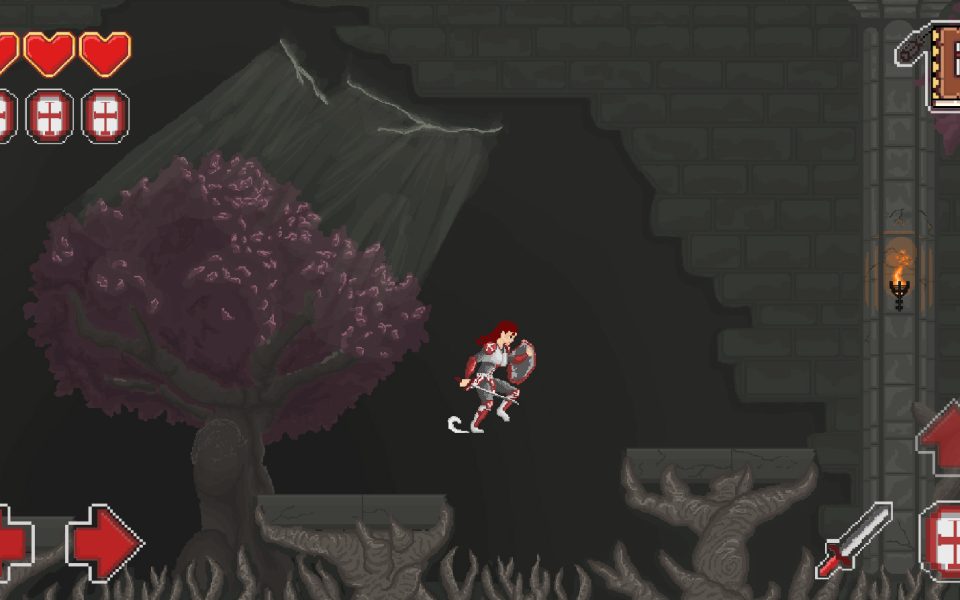On a mid-May morning, High Point University communications major Sam Schoenfeld and the rest of his game-design capstone team received the same vague message from their instructor Brian Heagney.
“Dear students: Please read the email below,” signed Heagney.
The banality of the communiqué obscured its urgency. The game Schoenfeld, Michael Messer, Callum Boothman and Spencer Hitchcock created, “Guinevere and the Fallen King,” had been nominated as a finalist in the College Game Competition at the 2016 Electronic Entertainment Expo, or E3 — the gaming industry’s premier convention.
The news struck the quartet like a blow from Excalibur.
“I was flabbergasted,” Schoenfeld recalled. “I’m still waiting for an email saying, ‘This is a mistake,’ but it’s only a couple days away now, so I guess it’s too late for that.”
The team developed “Guinevere and the Fallen King” over the spring semester as a “vertical slice” — basically, a demo — initially for mobile platforms such as iOS and Android.
“Our summer plan, provisionally, was for me and my programmer [Messer] to keep working and making the game,” Schoenfeld said. “But we got lucky, so now, we’re going to E3.”
The theoretical full game, as the title suggests, follows Lady Guinevere of Arthurian legend in search of her husband following his supernatural passing.
“You play other fantasy games, and there’s orcs and elves and all this other stuff, and there’s really no rhyme or reason to it,” Schoenfeld said. “It’s a world-building cliché based on Tolkien.
“Well, no one ever talks about King Arthur,” Schoenfeld continued. “There’s been nothing about King Arthur since that really bad 2004 movie. It’s such a rich world with all the characters in the public domain, so I said, ‘Let’s keep it going, see what happens.’”
Aside from Arthurian legend, “Guinevere and the Fallen King” draws inspiration from classic side-scrolling platformers like Castlevania and Super Mario Bros., the Zelda series, the simple mechanics of GameBoy games and even newer-generation titles like “Super Smash Brothers.”
“We wanted to evoke that old-school feel in gameplay and how it looks, but kind of modernize it — speed it up a little bit, make it look a little fresher,” Schoenfeld said.
![Sam Schoenfeld (r) and Michael Messer discuss their brainchild, “Guinevere and the Fallen King,” in the High Point University game lab. [courtesy photo]](https://i0.wp.com/sam.beat-media.com/wp-content/uploads/imported-files/messer-schoenfeld.jpg?resize=300%2C200&ssl=1)
©
Schoenfeld — Guinevere’s lead artist, animator and creative director — conceptualized the game toward the end of his junior year in the HPU game lab. He’d been doodling a female knight who he named Guinevere.
“I was like, ‘Huh, I’ve got this character; what could I do with her?’” Schoenfeld said.
Schoenfeld revisited major works of Arthurian legend, poring over Alfred, Lord Tennyson’s narrative-poem cycle Idylls of the King and Sir Thomas Malory’s Le Morte d’Arthur like a medieval scribe.
“Guinevere’s hypothetically still pretty young by the end of it,” Schoenfeld said. “She’s in her late twenties, and Arthur never comes back after he suffers that grievous injury at the hand of Mordred [his illegitimate son]. So what if he never returned, Morgan le Fay [Arthur’s sorceress half-sister] was siphoning off his kingly power, Camelot was in ruins, all the Knights of the Round Table are dead and there’s civil war? What if she’s the last person to take up the mantle?”
Schoenfeld conceived this narrative as “a redemption journey” for Guinevere, who infamously shacked up with Arthur’s greatest knight, Sir Lancelot, their tryst partly leading to Camelot’s downfall.
“It’s kind of her fault in the first place,” Schoenfeld said with a rough chuckle.
But he emphasized Guinevere’s role as a strong female lead, a growing trend in games, in order to explore an “underserviced” character.
“We thought, Let’s put the spotlight on her and see things from her perspective, as opposed to the original poems which were male-dominated — men writing for men — just like in games, you have guys making games for other guys,” Schoenfeld said.
An ironic twist to its success: Heagney admitted initial hesitation at the game’s proposed scope.
“I thought that they’d never finish it,” Heagney said.
Despite Guinevere’s nostalgic novelty, the small team faces stiff competition from games submitted by students at the University of Southern California and Savannah College of Art and Design — some with teams of 100 people and multiple semesters-worth of development.
Like stoic, stalwart knights, Schoenfeld and Heagney retain optimism.
 “The thing that’s awesome about this is not whether or not they win,” Heagney said. “This is a golden opportunity for them to impress themselves upon people in the industry.”
“The thing that’s awesome about this is not whether or not they win,” Heagney said. “This is a golden opportunity for them to impress themselves upon people in the industry.”
“I think it’s such a testament to our team and all our hard work that we placed in the top five with so few people and so little time,” Schoenfeld said. “I think it means we’re onto something big or something solid with our game.”
Following E3, the Guinevere team plans to release their demo on the game’s website, currently in development. They may also publish Guinevere on Steam, a digital game-distribution service, and launch a Kickstarter campaign.
“We’ve looked at this project under a microscope for so long, all we see are the flaws, the little issues, the bugs,” Schoenfeld said. “We don’t see it for what players are coming up and experiencing.”
Join the First Amendment Society, a membership that goes directly to funding TCB‘s newsroom.
We believe that reporting can save the world.
The TCB First Amendment Society recognizes the vital role of a free, unfettered press with a bundling of local experiences designed to build community, and unique engagements with our newsroom that will help you understand, and shape, local journalism’s critical role in uplifting the people in our cities.
All revenue goes directly into the newsroom as reporters’ salaries and freelance commissions.


Leave a Reply